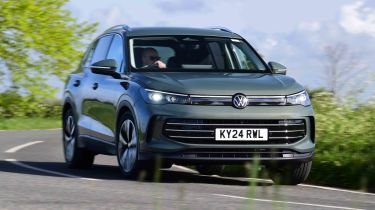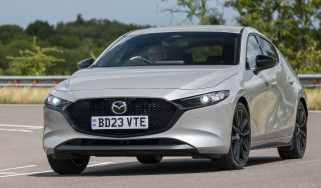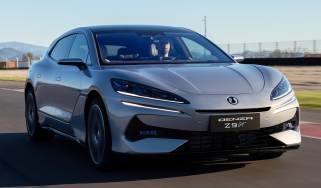Volkswagen Tiguan - Engines, performance & drive
A wide range of engines offer good performance, but the Tiguan has a firm ride on bigger wheels

Petrol power for the Volkswagen Tiguan comes from the company’s 1.5 TSI turbo four-cylinder in 128bhp or 148bhp forms, with the former only offered in lower specs. Further up the range, a 2.0 TSI is available in R-Line and Black Edition models, with 201bhp or 261bhp and 4MOTION four-wheel drive as standard for both engines.
Diesel fans have access to a 148bhp 2.0 TDI in the majority of specs, while the eHybrid uses a 1.5 TSI petrol engine combined with an electric motor and 25.7kWh battery. The engine is largely the same as the petrol model’s except it runs slightly differently to boost efficiency, while the electric motor is integrated into a bespoke six-speed twin-clutch gearbox.
Two power outputs are offered – 201bhp or 268bhp – although unlike the similarly powerful 2.0 TSI models, the eHybrids are front-wheel drive, as with the rest of the range. All versions of the Tiguan come with automatic gearboxes – there are no manuals.
| Model | Power | 0-62mph | Top speed |
| Tiguan 1.5 eTSI 130 DSG | 128bhp | 10.6 seconds | 123mph |
| Tiguan 2.0 TSI 265 DSG | 148bhp | 5.9 seconds | 150mph |
| Tiguan 2.0 TDI 150 DSG | bhp | 9.4 seconds | 129mph |
What is the Volkswagen Tiguan like to drive?
There’s a firm edge to the Tiguan’s ride, especially in higher-spec cars, but overall it’s comfortable and easy to get along with.
Ultimately, the Tiguan is never going to be a car for keen drivers, but clever software means it’s safe and secure even if you take a corner a little too quickly. It’ll satisfy the needs of the majority in everyday driving, providing a grippy chassis and precise steering. There’s perhaps a little more body lean in bends than you’ll find in a Ford Kuga or SEAT Ateca, while the ride could do with being a bit more comfortable.
In town
Responsive controls and sure-footed handling mean that the Tiguan is easy to drive in urban areas, although bumps do tend to thump into the cabin – smaller wheels should make things smoother. All versions come with front and rear parking sensors and a reversing camera, while higher-spec variants add kit such as a 360-degree camera and remote parking tech.
Used - available now

2024 Volkswagen
Tiguan
11,947 milesAutomaticPetrol1.5L
Cash £21,800
2023 Volkswagen
Tiguan
35,667 milesAutomaticPetrol1.5L
Cash £24,900
2020 Volkswagen
Tiguan
45,239 milesAutomaticDiesel2.0L
Cash £17,106
2023 Volkswagen
Tiguan
23,284 milesAutomaticPetrol1.5L
Cash £22,900The eHybrid offers quiet and refined running when fully charged, and it’s responsive to inputs without resorting to petrol power if there’s enough capacity left in the battery. But once the engine does cut in, the experience isn’t quite so smooth. The transition between electric and combustion drive is jerky, and at low speeds (when exiting a junction, for example) the VW can hesitate as it decides which power source to use.
The auto-hold handbrake adds to the jerkiness, because it needs a firm prod of the accelerator to disengage, which causes the Tiguan to lurch forward as the power comes in – we’d recommend leaving the system off for a smoother drive.
On A- and B-roads
At higher speeds the Tiguan’s firm ride softens off, and the car offers positive responses, with direct steering that is short on feedback but has decent weight. There’s stiffer suspension for R-Line trim that feels a bit harsher than the standard car’s, but for the best experience we would recommend upgrading to the £1,025 Dynamic Driving Package. This includes Adaptive Chassis Control that comes with adjustable dampers, which can be set from soft to firm and deliver better comfort than the standard set-up, although overall it’s still on the firm side.
The eHybrid favours electric drive as often as possible, but when the engine does cut in, it’s by no means harsh. The extra weight of the hybrid system doesn’t have much of a detrimental effect on handling, either.
On the motorway
With a fairly even split in power delivery from the electric motor and engine, the Tiguan will favour electric drive even at higher speeds. It’s only when accelerating on slip roads that the engine is most vocal, but even then it’s far from being harsh.
The firm edge to the VW’s ride is still present at motorway speeds. Higher-spec cars on larger wheels suffer from a bit of road noise, too, although it’s not loud enough to make conversation with passengers difficult.
Engines, 0-60 acceleration and top speed
The Volkswagen Tiguan’s acceleration times start with the 128bhp 1.5 eTSI, which manages 0-62mph in 10.6 seconds and has a top speed of 123mph. Our preferred engine is the 148bhp 1.5 eTSI, and its extra power and torque (250Nm versus 220Nm) trims the acceleration time to 9.1 seconds, while the top speed rises to 130mph. It’s a responsive engine, and it works well with the standard seven-speed DSG automatic gearbox.
The 2.0 TDI diesel also gets 148bhp, but has 360Nm of torque. However, it isn’t as responsive as the petrol, so 0-62mph takes 9.4 seconds. This engine’s talents lie in offering low-rev grunt (maximum torque arrives at 1,600rpm) and the ability to tow heavier trailers or caravans. Top speed is 129mph.
VW’s 4MOTION four-wheel drive is available with VW’s 2.0 TSI petrol in two power outputs. The first comes with 201bhp and 320Nm of torque for 0-62mph in 7.1 seconds and a 142mph top speed. Those after the fastest Tiguan will want the 261bhp version, which rattles off the 0-62mph dash in 5.9 seconds and has a top speed of 150mph.
A more affordable bet for company car drivers will be one of the two plug-in eHybrid models with either 201bhp or 268bhp. The former manages 0-62mph in 8.2 seconds, while the most powerful eHybrid will do it in 7.2 seconds. Unlike the 2.0 TSIs, these two models only come with front-wheel drive.








